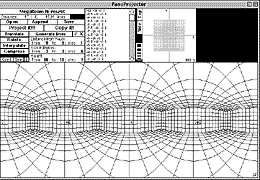3D Stuff
All the software on this page only runs in the Classic Mac OS, and the stacks require HyperCard or the HyperCard Player. You can emulate classic Mac OS in OS X, Windows and Linux with SheepShaver or BasiliskII.
The Models • 3D Parametric Equations • Rotater Manipulater • PanoProjector
This page features some 3D models which can be viewed in the freeWare program Rotater, and three HyperCard stacks: "3D Parametric Equations", which can generate such models from parametric equations of curves and surfaces; "Rotater Manipulater", a stack which can merge, rotate, translate, scale and optimize Rotater files; and "PanoProjector", which makes panoramic projections of Rotater files, which can be transformed into QTVR panoramas.
Rotater is a program which allows you to view and rotate 3D models consisting of lines and/or dots, with various options like stereo view and different levels of perspective. The program is widely spread on the Macintosh platform but a DOS version (called "Rotate") is available too. These programs as well as lots of 3D files can both be downloaded from the Rotater webpage (amazingly, still alive and kicking with new versions in 2023).
For more information about HyperCard and some other stacks, check out my HyperCard page.
The Models
Because I'm pretty tight on disk space here, I had to compress the files, they are all stuffed into one archive.
The archive contains the following models:
Clutter, Pillow1722, Saucer, SineCircle, Sphere1665, Torus, WaterDrop, WaveSurface1, WaveSurface1-dots, WaveSurface2, WeirdCurve.
The uncompressed files take 520 K.
Click here to download the 3D Models as a StuffIt archive
Click here to download the 3D Models as a ZIP archive
3D Parametric Equations

This HyperCard stack draws isometric projections of three-dimensional curves and surfaces (wire-frame). Curves are described with 3 equations in one parameter, and surfaces with 3 equations in two parameters. The curves and surfaces can be exported to Rotater files, of which the files above are an example. There are various export options, like choosing between the 7 available colours, exporting dots or lines and varying the colour according to the z-coordinate of each point. The number of digits after the decimal point can be chosen between 0 and 20, but in most cases 4 digits are amply sufficient.
The stack is freeWare, it may be copied and spread as long as no money is charged for it and the "ReadMe" file is included.
Click here to download 3D Parametric Equations (StuffIt archive)
Rotater Manipulater
With this stack you can edit and merge Rotater files. The stack offers the following functions: scale, translate, center and rotate. You can also clean the file from useless commands, or reduce the number of points. The number of digits which is used with the transformations can be set between 0 and 20 and this feature can also be used to reduce the number of digits in a file, an operation which in most cases will have no visible effect, but reduces the file's size significantly. You can also remove or add comments or delete separate points in the first 30K of the file.
Erratum: in the help, you can read that you should use a f.o.v. of 90° for a natural view of the perspective projection. This is incorrect and should be 45° (because of the narrow projection window).
The stack is freeWare, it may be copied and spread as long as no money is charged for it and the "ReadMe" file is included.
Click here to download Rotater Manipulater (StuffIt file)
(A LiveCode port of this stack has been made by Alejandro Tejada Capellan. Unfortunately I can no longer find any download links for it. The webpage used to be at: andregarzia.on-rev.com/alejandro/ but although it can be found in the Internet Archive, the actual download file cannot.)
PanoProjector

This stack generates panoramic projections from Rotater files. A panoramic projection is a 360° view of a scene, projected on a cylinder. This system is used in QTVR panoramas, so the images created with this stack can be converted directly into panoramas with the free ‘Make QTVR Panorama’ application from Apple.
The stack also offers the basic transformations like translate and rotate, which is useful because most Rotater files are not intended for panoramic projection and only make sense after translating. You can also generate sets of lines parallel to each of the axes. The stack can also tell you which is the recommended zoom setting for a natural 90° vertical-field-of-view for each image size.
The stack is freeWare, it may be copied and spread as long as no money is charged for it and the "ReadMe" file is included.
Click here to download PanoProjector (StuffIt file)
If you have questions, comments or suggestions concerning these files or programs, contact me by clicking here.
The three stacks need HyperCard (2.0 or newer) to run, or the HyperCard Player, which used to be available at the Apple site although nowadays you would need to look in classic Mac software archives instead.